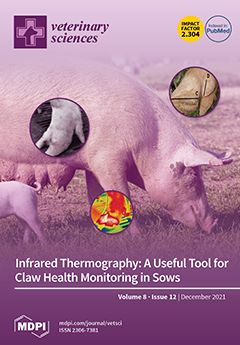Ruminal pH is an important physiological parameter that regulates microbe activity; optimizing ruminal pH may improve rumen fermentation and milk production. The purpose of this experiment was to determine the effect of sodium bicarbonate (NaHCO
3) or selenium (Se) in mineral salt block (MSB) supplementation on ruminal pH, rumen fermentation, milk yield and composition in Holstein Friesian crossbred dairy cows. Four crossbred dairy cows with an initial weight of 456 ± 6 kg in mid-lactation were assigned at random using a 4 × 4 Latin square design. The experiments were divided into four periods, each lasting 21 days. Each cow was fed a basal diet supplemented with a different type of mineral salt block: a control with no MSB supplementation, and MSB groups with MSB containing NaHCO
3 (MSB-Na), MSB containing Se (MSB-Se), and conventional commercial MSB (MSB-Com). MSB-Na contained NaHCO
3 (500 g/kg) to prevent acidosis, MSB-Se contained organic Se (15 mg/kg) as an antioxidant, and MSB-Com was a positive control mineral salt block. The results show that there was no significant difference in feed intake between treatments, but there was a significant difference in mineral salt intake between treatments (
p < 0.05). Supplementing mineral blocks had no effect on nutrient intake or apparent digestibility (
p > 0.05). Ruminal pH was not different between treatments at 0 and 1 h post-feeding, but at 2 and 4 h post-feeding, ruminal pH in cows fed MSB-Na and MSB-Se was significantly higher (
p < 0.05) than it was in cows fed MSB-Com and the control. Total volatile fatty acid (VFA), acetic, propionic, butyric, and ammonia nitrogen and blood urea nitrogen were not influenced by mineral blocks supplementation. Milk yield, milk composition and energy-corrected milk (ECM) were not affected by supplementing mineral blocks. However, compared with the control, the somatic cell count (SCC) in the milk was reduced (
p < 0.05) by supplementation with the mineral salt block. Based on the results of the experiments, it was concluded that MSB-Na or MSB-Se supplementation improved ruminal pH while having no effect on feed intake, rumen fermentation, milk yield, or composition, though it did reduce SCC in milk. However, additional research should be conducted to investigate the effect of MSB on rumen ecology and milk production in dairy cows fed a high-concentrate diet.
Full article






